|
JUNE 2019

Introduction
In the 1950s, not long after my tenth birthday, I walked over to
"Town" on an errand for my mother.
As usual, on the way back I took a short detour past Boslet's
Hobby Shop on
Herzog Place
. In the window, I saw
something new:

HO Scale Heinz Pickle Car
model by Revell Inc., c.1957
worthpoint.com
A railroad car built to carry only
vats of pickles seemed strange to my young brain.
On the wall next to the model there were old photographs,
pictures of a local pickle works.
Hicksville
had had a pickle factory? For
the first time, I really understood that, before the shiny new suburbs
of my childhood popped up, there once had been a rural village here.
It would be many years - decades -
before I looked back to that day, and decided to investigate the story
of
Hicksville
's Heinz pickle works.
***
Good-bye Barrels, Hello
Jars
It was the 1890s.
America
was nearing the end of one hundred years of remarkable change, change
that had taken it out of the world of Thomas Jefferson, and would soon
bring it into the world of Teddy Roosevelt.
A very tangible part of that change was the way the nation fed
itself. Rural families had
always cured home-grown produce in ceramic crocks.
They used root cellars for winter storage of their durable
vegetables (cabbages, potatoes, onions, carrots).
Once Mr. Mason invented his jars, things got easier, but the task
still had to be done.
By mid-century, however, the rise of industry meant that people
increasingly lived in cities. Tenements
had no gardens or root cellars. Most
blue-collar urban families, many of whom were immigrants, were
reluctantly learning to live without preserving their own foods.
City folk had to buy, not grow, what they ate, and no matter what
they bought, it probably was far different from the foods they
preferred.
Consider the phrase "pickle barrel."
Even today, it evokes nostalgia for crunchy, tasty dill pickles
in old-time country stores. The
obvious implication is that dill pickles offered a more memorable taste
than anything else the store sold - and sadly, they probably did.
Until the waves of Italians, Germans, Slavs, Asians, etc. broke
on our shores, much American food was not heavily spiced, and immigrants
found it bland.
Around 1860,
Pittsburgh
teenager John Henry Heinz had pioneered the concept of putting
commercially-prepared foods into jars.
He began by selling his own prepared horse radish door-to-door.
Soon, his business grew large enough to begin supplying his
products to merchants. By
the 1890s, American stores were stocking their shelves with a great
number of his tasty items, items which evoked the delicacies that
customers might recall from "the old country."
He offered many types of pickled cucumber items, marinated in a
choice of spices, as well as pickled cauliflower, pepper, and tomato
products. His concoctions
gave grateful customers a choice of ways to complement the affordable
meats that blue-collar families ate.
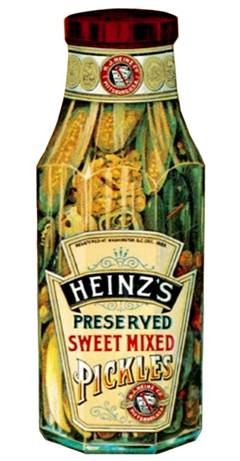
Crate-label
painting of
Heinz "octagon jar" with mixed pickles c.1894
morfauction.com
Eventually, Mr. Heinz hit on the idea of emphasizing
the multitude of choices his company offered.
He began advertising its "57 Varieties" - 57 being a number
he felt would stay in the public's mind (in reality, he was already
selling more products than that). The
Heinz Company grew steadily, encompassing
distant markets and growers almost all over the world.

H.
J. Heinz Company advertisement, 1924
archbridgeinstitute.org
***
A Plant Grows in Hicksville
Obviously,
Brooklyn and
New York City
(they had yet to join together in one municipality) constituted a major
sales market. At the time,
Heinz already had a limited pickle-salting operation near Port
Jefferson, but putting an actual factory on
Long Island
, closer to the City, would offer advantages.
Shipping supplies and finished products would be convenient.
Perhaps more important, increasing the company's total Long
Island capacity would mean having local farmers
commit
more of their crops to Heinz. This
would leave L.I. farmers with less produce to sell to competitors of the
company, which would help Heinz solidify its market share.
Would
a town on western
Long Island
welcome a new Heinz factory? Unquestionably.
H. J. Heinz Co. was a legendary success - a "clean"
thriving business with happy employees.
It had earned a reputation for paying employees a fair, but not
high, wage. Important to its
ethic was offering its employees (many of them women) clean, safe, and
humane "Christian" working conditions.
Compared to working in other factories, a job at Heinz was
practically a blessing.
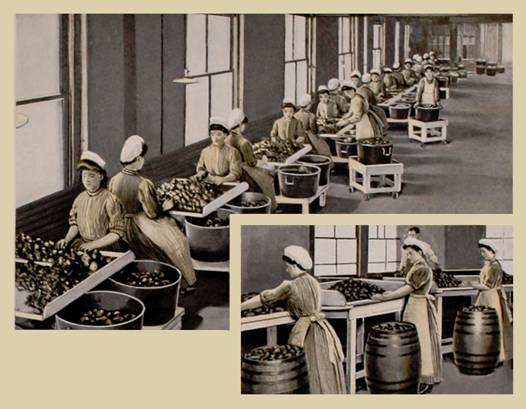
Uniformed workers sorting and
counting pickles at a Heinz factory c.1910
"H. J. Heinz Company, Producers, Manufacturers and Distributers [sic],
Pure Food Products"
Internet Archive
For
the town itself, getting a Heinz factory meant construction jobs, new
prosperity for farmers, and higher employment levels.
It also "said something" about the place; after all, the
world-famous Mr. Heinz could easily have put his factory in some other
town instead.
Thus,
when the Heinz Company talked, small towns listened eagerly.
Who first spoke to whom about the matter is not evident, but this
news item was published late in 1892:

Newtown
Register, November 10, 1892
And
so, as 1893 began, "the people of
Hicksville
" resolved to give land to the company - a standard commitment made by any
community that wanted a Heinz presence.
It was a tract of seven acres, adjacent to the tracks of the LIRR
branch to Port Jefferson, between
Park Avenue
and
Bethpage Road
.
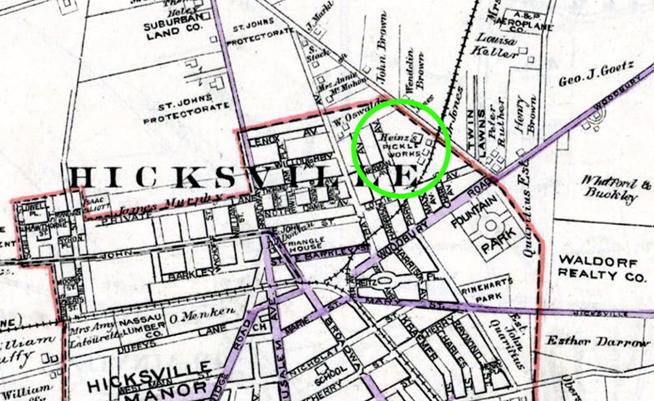
E. Belcher Hyde 1914 Atlas of
Nassau
County
(highlight added)

Newtown
Register, January 5, 1893
Within a week, the company accepted the offer.
Soon, the following advertisement was placed in local newspapers:
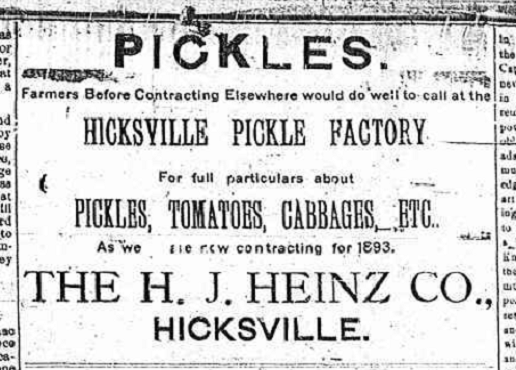
Huntington
Long-Islander, January 28, 1893
It was late January, and
Long Island
was thoroughly frozen. No
farmer's plow or builder's shovel would penetrate
Hicksville
's cold soil for months - and farmers were pledging the year's
unplanted crops to Heinz.
***
Joining the Heinz Empire
Everyone seemed satisfied by the agreement.
At the very end of April, ground finally was broken; at the same
time, the LIRR began
constructing a 200-yard-long rail connection to serve the complex.
The first part of the factory (three stories tall, and at 64 x 80
feet less than half its final size) was constructed, as was a salting
house (for turning cucumbers into pickles, and cabbage into sauerkraut),
and a power plant with a boiler. A
well was dug, and a reserve water tank built.

H.J. Heinz Factory No. 3 in Hicksville c.1910
The Salting House (left) had tripled its size in 1894, and would expand
further.
"H. J. Heinz Company, Producers, Manufacturers and Distributers [sic],
Pure Food Products"
Internet Archive
Through
the spring and early summer of 1893, successive news reports eagerly
followed the progress: excavation, masonry work, deliveries of
equipment, final painting, etc. One
report admired the factory's large sign, painted (of course) by a
Hicksvillian. As the local
farmers toiled to deliver the first year's twenty million cucumbers
-
America
certainly did like its pickles - the works began operating.
Things had settled in nicely by the time the fall harvest began.
In September, H. J. Heinz himself came to
Hicksville
, in order to survey the latest outpost of his domain.
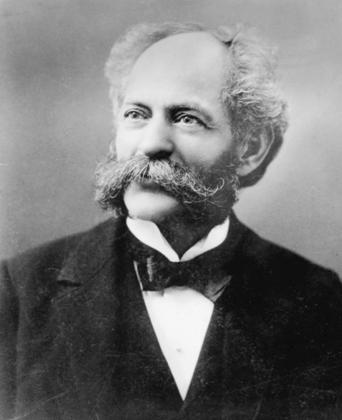
Henry John Heinz
Smithsonian Institution
In October, the Long-Islander
reported that most of the first year's pickles already had been
shipped, but that Heinz had contracts to ship one hundred more carloads
by November. Meanwhile, the
Salting House was processing 1,300 tons of cabbage into sauerkraut, and
it expected that by mid-November it would receive 2,500 more tons.
Hicksville
had never before experienced anything of this magnitude.
***
Beyond the Pickle
From the 1890s through the 1910s, the complex continued to thrive,
growing until the site occupied ten acres.
The investment and expansion were not surprising, for the
Hicksville
operation was more important to the business than one might realize
today.
Although the company had dozens of pickle-salting operations around the
nation, it had only twelve branch factories, which made more of those
"57" products than pickles, including four varieties of vinegar.
Heinz was considered the world's largest manufacturer of
vinegar, and only six of its factories produced it.
Hicksville
was one of them. In the
photograph below, the building in the rear likely was the one which
housed the hydraulic presses and the fermenting / distilling equipment
needed for vinegar production.
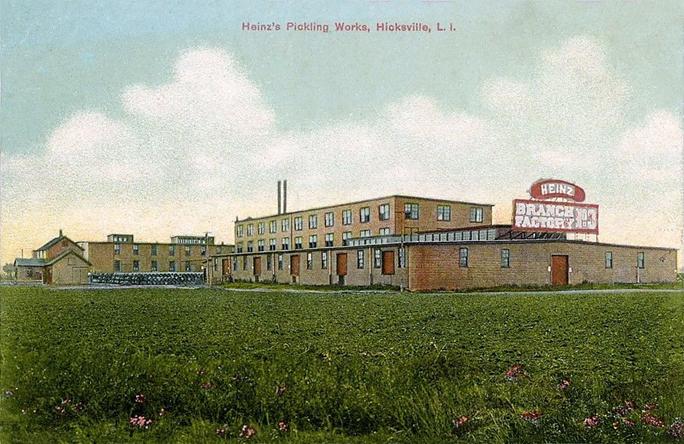
Postcard of Heinz complex in
Hicksville
Note the rows of stacked barrels to the left.
Pinterest
Occasionally, the plant was in the news.
For example, there was a sauerkraut workers' strike in the
autumn of 1899. Newspaper
accounts do not fully explain the strikers' agenda.
Reportedly, they complained about consistently working very long
hours (doubtless to be expected during the peak harvest season).
Presumably, they were being paid for the time they worked.
The striking workers wanted their employer to hire more
employees, so that all the employees would each work less.
This sounds rather altruistic, but it also sounds unlikely -
would factory workers in the 1890s strike to win the right to work less
and bring home less money? There
must have been more to it than was reported.
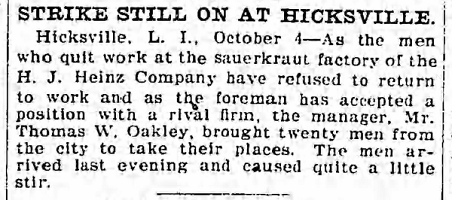
The
Brooklyn
Daily Eagle, October 4, 1899
Now and then, there were minor mishaps, and consequent injuries, as
staff installed or maintained machinery.
I have found no reports of any fatal accidents, although
ironically, while visiting
Long Island
, Mrs. Heinz - identified somewhat charmingly below as "Wife of
Pickle Man" - had a close call.
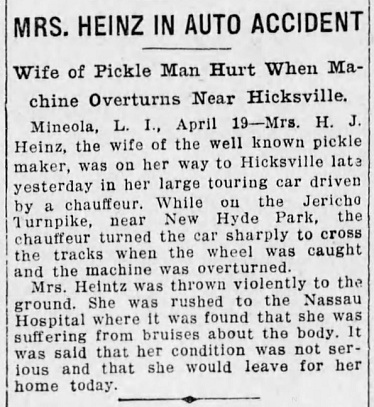
The
Brooklyn
Daily Eagle, April 12, 1912
***
Blight at the End of the
Tunnel
Around 1919,
Long Island
's pickle industry saw its first hints of trouble.
Here and there, blights, especially White-Pickle
Disease (also called Mosaic),
appeared in the great cucumber fields.
Instead of green cucumbers, farmers' labors began to yield
repulsive, white, inedible lumps.

"Diseases and Insects of Garden Vegetables"
USDA Farmer's Bulletin No. 1371, 1924
Googlebooks.com
In hindsight, it is easy to say - as
could later be said also of potatoes - that in this era, growing many
millions of bushels of produce, year after year, on densely farmed
Long Island
made epidemics of blight inevitable.
In this case, the primary vectors for spreading the diseases were
small (1/4" long), rather handsome yellow-and-black cucumber beetles,
especially the striped and twelve-spotted species shown at the beginning
of this article.
By August 1920, newspapers reported that cucumber and cabbage fields on
Long Island
had shrunk significantly because of blight.
The present crop had started well, but by late summer much of its
yield was threatened, by both blight and drought.
Desperate officials convened conferences, seeking guidance from
agricultural experts. Alas,
the situation was beyond control. Things
went very badly, even sooner than most people feared.
Only one year later, some farms failed, and those that remained
active were harvesting only 20% to 60% of what they had committed to
produce.

The
Brooklyn
Daily Eagle
With little or no usable harvest available, and a future that looked
even worse, the Heinz complex had become unsustainable.
After nearly thirty years, the
Hicksville
pickle works story ended as suddenly as it had begun.
The local Heinz factory was far from the only pickle business
casualty: competitors in Farmingdale, Greenport, and towns to the east
all went the same way.

Huntington
Long-Islander,
June 23, 1922
Local farmers started to realize that
Hicksville
's agricultural heyday would not last forever; change was already
coming, bit by bit. Some
hoped to hang on as long as they could by planting different crops.
Others reasoned that the best thing to do was to sell their land
to developers, who would divide it into lots and build on it.
A flurry of new construction began transforming the old farmland
- more houses, more people, and soon a new High School on
Jerusalem Avenue
.
What about the shuttered pickle works?
It facilitated the change. The
site once selected by the townspeople because of its railroad access and
proximity to farms would again prove convenient: it became a satellite
location for the
Brooklyn
lumber supplier who provided the wood for building all those new houses.
***
Epilogue: An
India
Relish Car
H. J. Heinz was proud of his accomplishments, and he saw no reason
to be timid or restrained about marketing his products.
He had hundreds of special freight cars built, and he had their
sides painted in eye-catching hues, so that they would serve as rolling
billboards. Whenever they
traversed
America
's countryside, they unabashedly advertised the products they carried.
Obviously, no color photographs from that era exist, but have no
fear, reader. After checking
several color print publications, I digitally altered a portion of this
photograph (taken at Heinz headquarters) to provide a glimpse of how
these cars' "billboard" sides looked.
Nifty, huh?
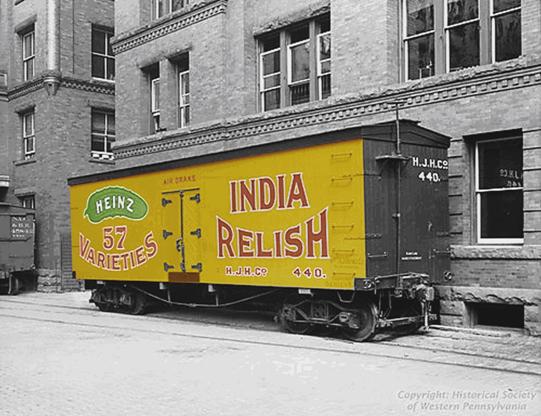
created using a black-and-white
photograph from
historicpittsburgh.org
More than sixty years after I first wondered about them, I have
answers to those old questions from my childhood.
Yes,
Hicksville
, you really once had a Heinz pickle works.
And yes, pickle cars once rode the country's rails - not to
mention vinegar cars, ketchup cars,
India
relish cars, and (believe it or not) apple butter cars.
***
Sources
In addition to the sources noted above, relevant information for this
article has been gleaned from:
The happy little critters below are visitors from
luv2garden.com's
Vegetable
Garden
Reference
Center
website at (https://luv2garden.com/cucumber_beetles.html)

*****
|


















